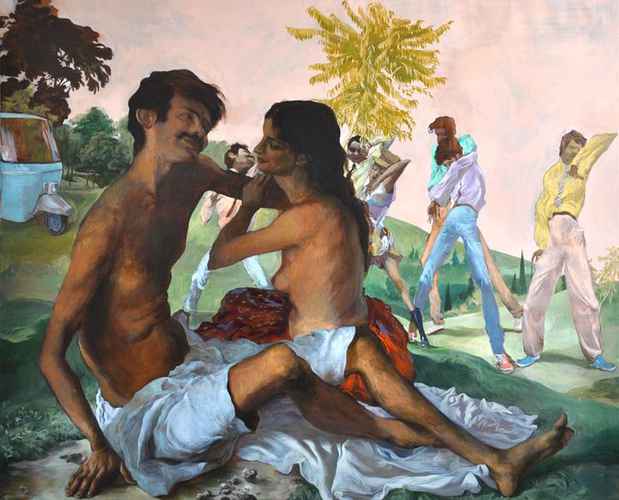Salman Toor “The Happy Servant”
Aicon Gallery

This event has ended.
Aicon Gallery New York presents The Happy Servant, an exhibition of recent works by Salman Toor. Toor’s paintings are an eclectic mix of the exhausted categories of old and new, where inspiration from Old Master painting techniques meld seamlessly with imagery from South Asian mass-media and popular culture, including graphic paintings from local Lahore cinema billboards and contemporary advertising from Bollywood and fashion magazines. The exhibition features a group of eleven paintings exploring the complex and often-uncomfortable relationships between servants and masters. Within these works, Toor transforms signs of poverty and commercial products into heroic symbols and absurdly idealized motifs through the metaphysical qualities of oil paint.
With Toor’s masterfully whimsical way with paint, these scenes are much more than the literal amalgamation of their commercial sources. Instead, they stage their own private masquerade, cloaking the fantasies of contemporary subjects with a veneer of museum-worthy Old Master virtuosity. The works, however, are not simply an exercise in technical skill, but rather the result of a complicated personal relationship with Western art history, by which the artist has re-interpreted his own place in his native social fabric. For Toor, aspiring towards the vivid scenes and technical perfection of the Renaissance and Baroque masters remains both a feasible and contemporary impulse, capable of yielding unique interpretations of the entrenched tenets of South Asian culture and advertising. In this lens, Toor’s work is set apart in an age of exhausted irony and innumerable iterations of commercial imagery.
In Girl with Driver, a salmon-colored Honda Civic becomes as luxurious as a silk cravat in an Ingres painting. The artist transforms this common sight in urban Pakistan – a woman in the backseat with a male driver up front – from its quotidian origins into an allegory of the humdrum of the present and the venerable painting of the past, simultaneously beautiful and grotesque. However, Toor’s realism is selective, which can be seen in the fantastical luminosity of the colors and stylized anatomy of the figures, while visual clichés - the woman smelling a flower from the car side – provide a running commentary of the absurd social subtexts of such a scene. The composition and typecast figures in this and other works are culled from the ubiquitous advertisements for jewelry, beauty products (‘Fairness Creams’), new shopping malls and cell phone providers dominating Pakistan’s urban media landscape.
Both The Rickshaw Driver’s Dream and Driver and Maid depict fantastic scenes of personal and collective wish-fulfilment through an impossible combination of visual references and cultural stereotypes, including the famous group dances of Bollywood musicals and the painted covers for Mills and Boon romance novels from the 1970s. The Rickshaw Driver borrows its compostion from Titian’s Three Ages of Man (circa 16th century Venice), which itself was most likely influenced by Giorgioni’s themes and motifs of landscapes and nude figures. In Toor’s work, this familiar scene of idyllic romance is pushed over the edge into Bollywood pathos by the presence of ever-ready backup dancers, who have spontaneously broken into their routine in support of the “leading couple.” In this cinematic trope, the class differences that typically dominate South Asian society are instantaneously dissolved and cooks, gardeners, landlords and drivers all rejoice in choreographed triumph for a singular imaginary couple. As a result, it highlights the comedically absurd nature of mass-marketed culture and advertising in modern-day India and Pakistan that often serves to mask a much darker social reality.
Similarly, poverty oscillates between caricature and reverence in The Happy Servant, while The Happy Sweeper brushes away in a sentimental Disneyland of daisies and four-leaf clovers. In both works, one senses the inherent isolation of the central figure in an otherwise carelessly jubilant gathering or classically-inspired milieu. Further emphasizing this skewed reality in both works are the subjects’ frozen smiles, which exude a foreboding quality slithering under a skin of frivolity.
In all his works, Toor deftly presents a subtle melding of the consumeristic and social fantasies perpetuated by the mass-media of urban India and Pakistan, along with a Renaissace-era spirit of light, technique and idealis. This collaboration presents a unique vision of the complexities and exchanges between South Asian popular culture and the art historical traditions of Western idealization. Salman Toor (b. 1983) lives and works between New York and Karachi, Pakistan. This is his first solo exhibition in New York.
[Image: Salman Toor “RICKSHAW DRIVER’S DREAM” (2013) Oil on linen, 48 x 59 in.]
Media
Schedule
from May 10, 2013 to June 29, 2013
Opening Reception on 2013-05-10 from 18:00 to 20:00